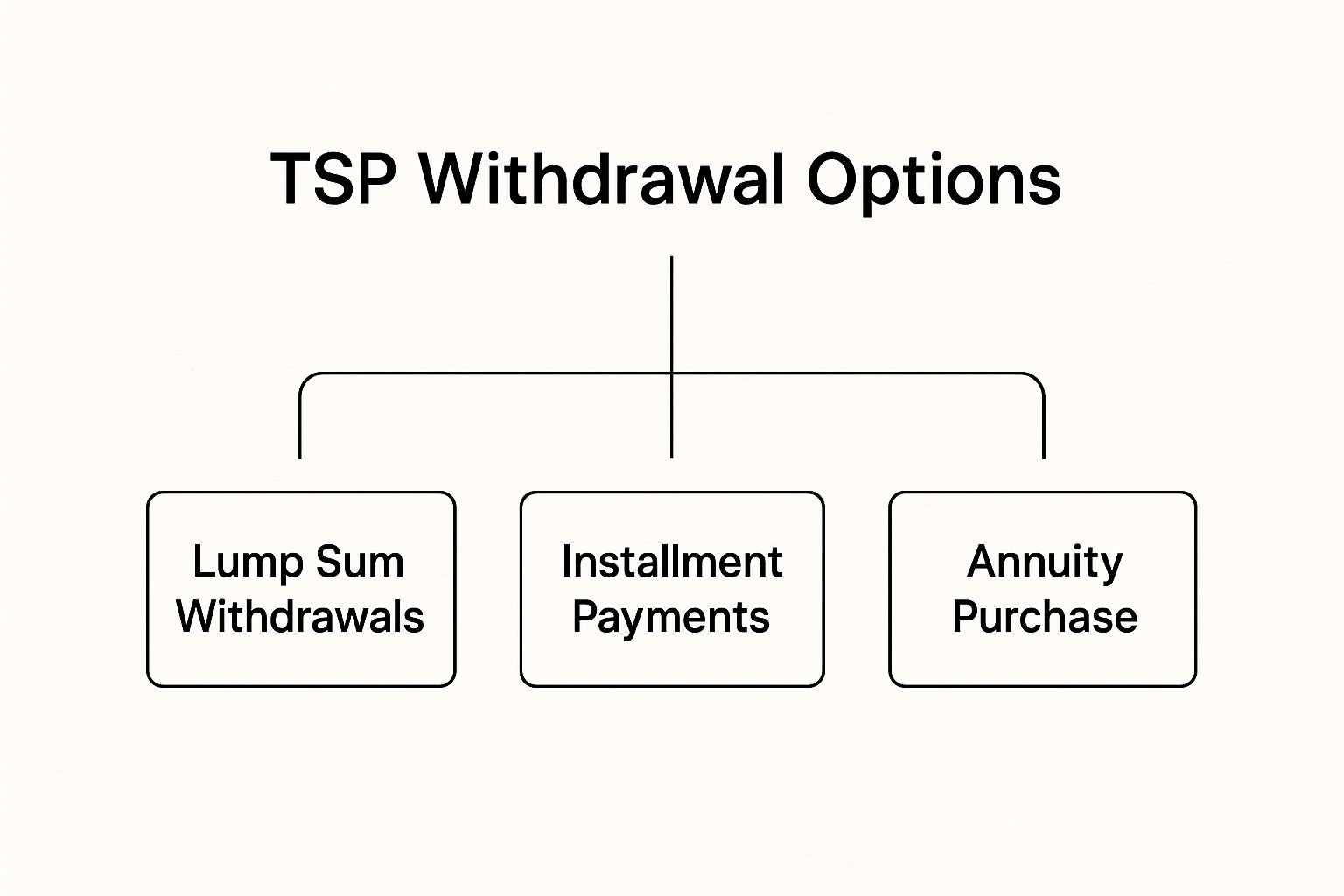Blogs

Blog title place here
We understand that every federal employee's situation is unique. Our solutions are designed to fit your specific needs.

Blog title place here
We understand that every federal employee's situation is unique. Our solutions are designed to fit your specific needs.

Blog title place here
We understand that every federal employee's situation is unique. Our solutions are designed to fit your specific needs.
Thrift Savings Plan Withdrawal Options: Your Complete Guide
Figuring out how to tap into your Thrift Savings Plan (TSP) funds is one of the biggest financial decisions you'll face as you approach retirement. You've got three main thrift savings plan withdrawal options: taking a lump-sum payment, setting up monthly installment payments, or buying a life annuity. Each one has its own set of pros and cons designed for different retirement lifestyles.
How to Choose Your TSP Withdrawal Strategy
Think of your TSP account as a financial reservoir you've spent years filling, drop by drop. Now it's time to decide how to open the tap. Do you want a big gush of water all at once, a steady trickle, or a guaranteed flow for life? The right choice depends on understanding exactly how each option works, the tax hit you'll take, and how it fits into your broader financial life.
This isn't a small decision. The TSP is the biggest defined contribution plan in the country, holding accounts for over 7.25 million people as of April 2025. And people are definitely tapping into their funds—in January 2025 alone, the TSP sent out over 1.3 million Form 1099-Rs for taxable withdrawals. You can dig into the numbers yourself in the official TSP participant activity reports.
The Three Core Withdrawal Paths
When you get right down to it, you're choosing between three fundamental ways to get your money, each serving a totally different need.
- Lump-Sum Withdrawals: This is exactly what it sounds like—taking a chunk, or even all, of your money at once. It gives you instant access to a lot of cash, but you've got to be ready for the tax bill that comes with it.
- Installment Payments: This route turns your TSP into a predictable income stream, almost like a retirement paycheck. You can set it up to pay you a fixed dollar amount or an amount calculated based on your life expectancy.
- Annuity Purchase: Here, you use your TSP balance to purchase a life annuity. This is the only option that guarantees you'll receive monthly payments for the rest of your life, no matter how long you live, much like a classic pension.
The diagram below gives a great visual of how these primary thrift savings plan withdrawal options branch out from your main account.

As you can see, every withdrawal starts from the same place—your TSP account—but leads to very different financial realities.
Before we dive deeper into each one, here is a quick table summarizing the main ways to access your TSP funds after you've left federal service.
Quick Guide to Post-Separation TSP Withdrawal Options
| Withdrawal Option | Payment Structure | Best For | Key Consideration |
|---|---|---|---|
| Lump-Sum Payment | One-time distribution of a partial or full account balance. | Immediate, large expenses like paying off a mortgage or buying a second home. | Significant, immediate tax liability that could push you into a higher bracket. |
| Installment Payments | Regular, recurring payments (monthly, quarterly, or annually). | Creating a predictable "paycheck" to cover ongoing living expenses in retirement. | Your remaining account balance is still subject to market fluctuations. |
| Life Annuity | A guaranteed stream of income for life, purchased from a private insurer. | Those who prioritize security and want to ensure they never outlive their money. | Irreversible decision; you give up control of the principal for the income guarantee. |
This table is just a starting point. The best strategies often blend these options.
The key is not to view these options in isolation. The most effective strategies often combine elements from each, such as taking a small lump sum for a specific goal while setting up installment payments for daily expenses.
Our goal here is to arm you with the knowledge to build a withdrawal plan that truly fits your vision for retirement. Once you understand the ins and outs of each approach, you can confidently turn that nest egg you worked so hard for into a secure and enjoyable future.
The Pros and Cons of a TSP Lump Sum Withdrawal
The thought of getting your entire Thrift Savings Plan balance in one big check is certainly appealing. This option, called a lump sum withdrawal, is one of the most direct thrift savings plan withdrawal options available. But it's a financial move with serious, long-term consequences that you absolutely have to think through.
It’s a bit like harvesting your entire orchard in a single afternoon. You’re suddenly sitting on a mountain of fruit, which is great, but now the trees are bare for every season that follows.
This withdrawal gives you total and immediate control over your life savings. You can take out a partial lump sum for a specific purpose or pull the entire account balance at once. For many, it feels like the perfect way to kick off retirement by paying off the mortgage, buying that lakeside cabin, or finally starting a small business.
Having all that cash on hand brings a powerful sense of freedom and security. But that instant access comes with some heavy trade-offs, especially when it comes to your tax bill and the long-term health of your retirement finances.
The Allure of Instant Financial Freedom
The biggest draw of a lump sum is having immediate access to your cash. If you’re carrying high-interest debt like credit card balances or personal loans, using a chunk of your TSP to wipe them out can instantly free up a lot of room in your monthly budget.
Some retirees also just want to simplify their finances and consolidate everything in one place. By taking a lump sum, you can roll the entire balance into an Individual Retirement Account (IRA). An IRA often provides a much wider universe of investment choices compared to the TSP's core funds, giving you more direct control over how your money is managed.
Here’s a quick rundown of why people find this option so compelling:
- Major Purchases: It gives you the cash for big-ticket items like a new home or major renovations without having to take out a new loan.
- Debt Elimination: Wiping the slate clean of a mortgage or other loans can be a huge psychological and financial relief as you enter retirement.
- Investment Control: Moving your funds to an IRA opens the door to individual stocks, a vast array of ETFs, and other assets you can't access inside the TSP.
While these benefits sound great, they're only half the story. The downsides, particularly the tax hit, can take a massive bite out of the nest egg you worked so hard to build.
The Serious Downsides of a Lump Sum Payout
The single biggest drawback of taking a large cash payout from your traditional TSP is the tax bill. The entire amount you withdraw is treated as ordinary income in the year you take it. That sudden, massive spike in income can easily catapult you into a much higher federal and even state tax bracket.
Let’s say you have a $700,000 traditional TSP balance. If you take it all at once, you could find yourself in the highest federal tax bracket. That means a huge slice of your savings—potentially 35% or more—is going straight to the IRS. Your nest egg could shrink by over $245,000 from taxes in a single year.
Taking a full lump sum withdrawal can trigger a massive, one-time tax event that permanently reduces your retirement principal. It's often the quickest way to lose a significant portion of the savings you spent a lifetime building.
Beyond that initial tax shock, there are other critical risks to consider:
- Loss of Tax-Deferred Growth: The moment that money leaves the TSP, it stops growing in a tax-advantaged environment. The magic of compounding that powered your account's growth for decades is gone for good on that withdrawn cash.
- Temptation to Overspend: It’s human nature. Having a huge sum of money sitting in a bank account can make it tempting to spend impulsively. Without ironclad discipline, it’s frighteningly easy to burn through your savings too quickly, leaving you in a tough spot later in life.
- Market Timing Risk: When you take a lump sum, you are effectively selling all of your TSP fund shares on one specific day. If the market happens to be down that day, you are forced to lock in those losses across your entire portfolio with no chance for recovery.
At the end of the day, a lump sum gives you maximum control, but it also strips away the protective structure that was designed to make your money last. It puts the entire burden of tax planning, investment management, and spending discipline squarely on your shoulders from day one of retirement.
Creating Predictable Income with Installment Payments

When you get down to it, most people just want one thing from their retirement savings: to replace the paycheck they’ve been getting for decades. This is where TSP installment payments really shine. They're specifically designed to turn your nest egg into a steady, reliable stream of income.
Think of it as creating your own personal pension. Instead of taking all your money out at once, you set up a regular cash flow to handle your living expenses, whether it's for groceries, travel, or anything in between. It's a smart middle ground that gives you a great mix of control and flexibility, often with a much friendlier tax impact than a lump-sum withdrawal.
The TSP gives you two different ways to set up these payments, and each one suits a different approach to managing your money in retirement.
Fixed Dollar Amount Payments
This is the most direct route. You simply tell the TSP how much money you want, and how often you want it—monthly, quarterly, or annually. It’s the retirement equivalent of setting a predictable monthly budget for yourself.
Let's say you've run the numbers and figured out you need an extra $2,500 a month to live comfortably on top of your FERS pension and Social Security. You can set up your TSP installments to deliver exactly that amount. This kind of predictability is fantastic for managing your cash flow and giving you peace of mind.
Of course, there's a trade-off. Your fixed payments won't automatically adjust for inflation or how the market is doing. If your investments take a hit, pulling out the same amount could drain your account faster than you'd like. On the flip side, if your funds do really well, your balance could keep growing even as you're taking money out.
The fixed dollar option gives you total control over your income right now, but it also puts all the responsibility for long-term planning squarely on your shoulders. You’ll need to check in on your account from time to time to make sure your withdrawal rate is still sustainable.
One of the best things to come out of the TSP Modernization Act is the ability to change this amount whenever you want. Got a surprise home repair? You can temporarily increase your payment. Find yourself spending less than you thought? You can dial it back to let more of your money grow.
Life Expectancy Based Payments
The second option is all about making your money last. With this method, the TSP does the math for you, calculating an annual payment based on your account balance and IRS life expectancy tables. The whole point is to create a stream of income that is mathematically set up to last for the rest of your life.
Because the calculation happens every year, your payment amount will change annually. It will go up if your investments had a good year and go down if they had a bad one. This built-in adjustment helps protect your account from getting drained too quickly during market downturns.
This is a great choice for retirees who want a professionally calculated, sustainable withdrawal plan without having to constantly crunch the numbers themselves.
- How it Works: Every year, the TSP takes your account balance from the end of the previous year and divides it by a life expectancy factor from the IRS's Uniform Lifetime Table.
- Automatic Adjustments: The payment amount naturally flexes with the market, which is a huge help in not running out of money.
- Peace of Mind: While it’s not a guarantee like an annuity, it provides a structured framework designed to make your savings last.
How well your TSP account is doing can have a big impact on your withdrawal strategy. For example, with the TSP’s total assets climbing past $1 trillion by September 2025, many participants are feeling more confident. The international (I) Fund led the pack with impressive year-to-date returns of 25.34%, and the popular Lifecycle (L) Funds also saw healthy gains. As highlighted in a 2025 government executive report, this kind of strong performance gives you more breathing room when deciding how much to withdraw.
At the end of the day, installment payments offer a fantastic middle path. You get the reliable income you need without the all-or-nothing finality of a lump-sum withdrawal or the inflexibility of an annuity, all while the rest of your money stays invested and working for you.
Tapping Your TSP While Still Working

Life happens. Sometimes, a financial curveball leaves you needing to access your savings well before you planned to retire. While most thrift savings plan withdrawal options are designed for after you leave federal service, the TSP does offer two ways to get to your money while you’re still on the job: a financial hardship withdrawal or a loan.
It's critical to see these options for what they are: lifelines for urgent situations, not shortcuts for extra cash. Tapping into your TSP early can seriously set back your long-term retirement goals. I often tell people to think of their TSP as a tree they're growing for the future. An early withdrawal isn't just picking some fruit—it's like sawing off a major branch, permanently stunting its growth potential.
When a Financial Hardship Withdrawal Makes Sense
A financial hardship withdrawal is exactly what it sounds like—a distribution for when you’re facing a genuine, immediate financial crisis. This isn't a loan you can repay. The money you take out is gone for good, and you'll owe ordinary income tax on it. If you're under age 59½, you'll also likely get hit with a 10% early withdrawal penalty from the IRS.
This option should be your absolute last resort. The TSP has very strict rules about what qualifies.
- Negative Monthly Cash Flow: You have to prove that you have ongoing negative cash flow you can't otherwise fix.
- Medical Expenses: This covers out-of-pocket costs for you, your spouse, or your dependents that insurance doesn't pay for.
- Personal Casualty Losses: For damage from events like fires or floods that aren’t covered by your insurance policy.
- Legal Expenses for Separation or Divorce: You can use the funds for attorney fees and other court costs.
Because this is a permanent hit to your retirement savings, you should only even think about it after you’ve exhausted all other options, including a TSP loan.
Using a TSP Loan to Borrow From Yourself
A TSP loan is a far more common—and much less damaging—way to access your money while you’re still working. You’re literally just borrowing from your own retirement account and paying yourself back, with interest. That interest doesn't go to a bank; it goes right back into your own TSP account, helping replenish what you borrowed.
This is a much better approach because it keeps your money working for you. The loan is simply secured by your account balance, while the rest of your TSP investments can continue to grow.
A TSP loan lets you handle a pressing financial need without permanently torpedoing your future retirement. By paying yourself back over time, you restore your account and keep your long-term plan on track.
You have two loan options to choose from:
- General-Purpose Loan: You can borrow for any reason, no questions asked. The repayment term is between one and five years.
- Residential Loan: This is specifically for buying or building your primary home. It comes with a much longer repayment window—up to fifteen years—but you'll need to provide documentation.
While participation in the TSP is incredibly high—95.9% of FERS employees were enrolled in 2024—recent data shows signs of financial strain. Loan usage ticked up to 8.6% in 2024, and hardship withdrawals hit an all-time high of 3.9%. As a recent PlanSponsor analysis noted, these trends suggest that more federal employees are feeling the pressure and turning to their retirement funds for help.
The biggest risk with a loan comes if you leave your federal job with a balance still outstanding. If you don't repay it in full by the deadline, the IRS treats the remaining amount as a taxable distribution. That can leave you with a surprisingly large tax bill and potential penalties.
Building Your Personal Withdrawal Blueprint

Knowing the different thrift savings plan withdrawal options is one thing. The real skill is in putting them together into a strategy that actually works for your life. There's no magic bullet here—the "best" plan is simply the one that aligns with your vision for retirement, your financial situation, and what lets you sleep at night.
Think of the withdrawal options as financial LEGOs. You can click different pieces together to build something that suits you perfectly. For instance, maybe you take a partial lump sum to finally pay off the house, then set up monthly installments to cover your regular bills. This kind of hybrid approach gives you both a big win upfront and predictable income for the long haul.
Assembling Your Financial Picture
Before you can build your blueprint, you need a clear view of all your income sources and planned expenses. This is about more than just your TSP; it's about crafting a comprehensive retirement income plan.
Start by getting honest answers to a few critical questions:
- What other income will I have? Don't forget to account for your FERS pension, Social Security benefits, and any other savings or investments you have. This helps you figure out how much heavy lifting your TSP actually needs to do.
- What will my retirement lifestyle cost? Get real about your budget. Tally up the essentials, factor in healthcare costs, and don't forget the fun stuff like travel and hobbies.
- How do I feel about risk? Are you okay with leaving money invested for potential growth, or would the guaranteed income from an annuity give you more peace of mind?
Your answers will naturally point you toward the right mix of withdrawal options. If your pension and Social Security already cover all your basic needs, for example, you might feel more comfortable taking a lump sum for a big purchase, knowing your core expenses are handled.
Your TSP withdrawal strategy shouldn't exist in a vacuum. It must work in concert with your other retirement assets to create a secure and sustainable income stream for the rest of your life.
Ultimately, designing the perfect plan is often easier with a little help. A financial advisor who specializes in federal benefits can help you see the entire board, including the all-important tax implications of each move. They can run different scenarios to make sure the plan you build today will hold up for years to come. Working with an expert, like the team at Federal Benefits Sherpa, can give you the clarity and confidence to make these crucial decisions.
Common Questions About TSP Withdrawals
Once you start digging into your thrift savings plan withdrawal options, a lot of questions pop up. It's only natural. As you get closer to retirement, you need clear, straightforward answers to feel good about the choices you're making. Let's tackle some of the most frequent questions we hear from federal employees.
We'll get into the nitty-gritty of how your withdrawals are taxed, what those pesky Required Minimum Distributions (RMDs) are all about, and whether moving your TSP to another account makes sense for you. This is your go-to guide for the finer details of using your TSP money in retirement.
How Are TSP Withdrawals Taxed?
This is the big one. How the tax man treats your TSP withdrawals comes down to one simple thing: whether your money is in a traditional or a Roth account. This single detail has a massive impact on your take-home pay in retirement.
With a traditional TSP, it's pretty straightforward. Every single dollar you pull out is taxed as ordinary income. That withdrawal gets added to your other income for the year—like your FERS pension or Social Security—and taxed at whatever your federal and state tax rates are at that time.
For a Roth TSP, the news is a lot better.
- Qualified Distributions: If you're at least 59½ years old and it's been five years since your first Roth contribution, every penny you withdraw is 100% tax-free. That includes both your original contributions and all the earnings.
- Non-Qualified Distributions: If you don't meet both of those requirements, your contributions still come out tax-free (since you already paid tax on them), but the earnings portion will be taxed.
What Are TSP Required Minimum Distributions?
The government doesn't let you keep your money in tax-advantaged retirement accounts indefinitely. Eventually, they want their tax revenue. Once you hit a certain age, currently age 73, the IRS requires you to start taking out a specific amount each year. This is what's known as a Required Minimum Distribution, or RMD.
Think of an RMD as the minimum amount you must withdraw from your traditional TSP account each year after you turn 73. If you don't take out enough on your own by the deadline, the TSP will calculate it and send you the payment automatically.
It's important to know this rule only applies to your traditional TSP balance. This is a huge perk of the Roth TSP—the original owner never has to take RMDs.
Can I Roll My TSP into an IRA?
Yes, you can. After you leave federal service, you have the option to roll your TSP funds into an Individual Retirement Account (IRA). This is a really common strategy for retirees who want access to a much wider world of investment options than what the TSP's core funds can offer.
Doing a rollover can also help you consolidate your retirement accounts in one place and might even give you more flexible withdrawal options. But don't jump into this decision too quickly. IRAs often have higher management fees than the TSP, which is famous for its rock-bottom costs. You have to weigh the pros and cons carefully—comparing fees, investment choices, and features—before you move a lifetime of savings.
Trying to figure all this out on your own can be overwhelming. Federal Benefits Sherpa specializes in guiding federal employees toward a retirement they can feel confident and clear about. Book your free 15-minute benefit review today and let us help you make the most of the benefits you've worked so hard for.

Dedicated to helping Federal employees nationwide.
“Sherpa” - Someone who guides others through complex challenges, helping them navigate difficult decisions and achieve their goals, much like a trusted advisor in the business world.
Email: [email protected]
Phone: (833) 753-1825
© 2024 Federalbenefitssherpa. All rights reserved

